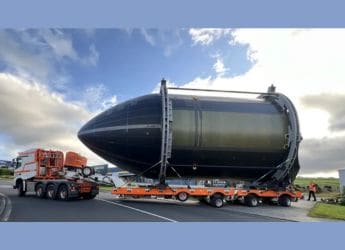- Home
- Science
- Science News
- NASA's Orion Spacecraft Enters Lunar Orbit a Week After Artemis I Launch
NASA's Orion Spacecraft Enters Lunar Orbit a Week After Artemis I Launch
NASA's Orion Spacecraft will begin the journey back to Earth, with a landing in the Pacific Ocean scheduled for December 11.

Photo Credit: Twitter/ @NASA
It will take Orion about a week to complete half an orbit around the Moon
NASA's Orion spacecraft was placed in lunar orbit Friday, officials said, as the much-delayed Moon mission proceeded successfully.
A little over a week after the spacecraft blasted off from Florida bound for the Moon, flight controllers "successfully performed a burn to insert Orion into a distant retrograde orbit," the US space agency said on its website.
The spacecraft is to take astronauts to the Moon in the coming years — the first to set foot on its surface since the last Apollo mission in 1972.
This first test flight, without a crew on board, aims to ensure that the vehicle is safe.
"The orbit is distant in that Orion will fly about 40,000 miles above the Moon," NASA said.
While in lunar orbit, flight controllers will monitor key systems and perform checkouts while in the environment of deep space, the agency said.
It will take Orion about a week to complete half an orbit around the Moon. It will then exit the orbit for the return journey home, according to NASA.
On Saturday, the ship is expected to go up to 40,000 miles beyond the Moon, a record for a habitable capsule. The current record is held by the Apollo 13 spacecraft at 248,655 miles (400,171 km) from Earth.
It will then begin the journey back to Earth, with a landing in the Pacific Ocean scheduled for December 11, after just over 25 days of flight.
The success of this mission will determine the future of the Artemis 2 mission, which will take astronauts around the Moon without landing, then Artemis 3, which will finally mark the return of humans to the lunar surface.
Those missions are scheduled to take place in 2024 and 2025, respectively.
Get your daily dose of tech news, reviews, and insights, in under 80 characters on Gadgets 360 Turbo. Connect with fellow tech lovers on our Forum. Follow us on X, Facebook, WhatsApp, Threads and Google News for instant updates. Catch all the action on our YouTube channel.
Related Stories
- Samsung Galaxy Unpacked 2025
- ChatGPT
- Redmi Note 14 Pro+
- iPhone 16
- Apple Vision Pro
- Oneplus 12
- OnePlus Nord CE 3 Lite 5G
- iPhone 13
- Xiaomi 14 Pro
- Oppo Find N3
- Tecno Spark Go (2023)
- Realme V30
- Best Phones Under 25000
- Samsung Galaxy S24 Series
- Cryptocurrency
- iQoo 12
- Samsung Galaxy S24 Ultra
- Giottus
- Samsung Galaxy Z Flip 5
- Apple 'Scary Fast'
- Housefull 5
- GoPro Hero 12 Black Review
- Invincible Season 2
- JioGlass
- HD Ready TV
- Laptop Under 50000
- Smartwatch Under 10000
- Latest Mobile Phones
- Compare Phones
- Redmi Note 15 5G
- Redmi Note 15 Pro 5G
- Redmi Note 15 Pro+ 5G
- Lava Play Max
- Poco C85 5G
- Honor Magic 8 Lite
- Jolla Phone
- Realme P4x 5G
- Asus ProArt P16
- MacBook Pro 14-inch (M5, 2025)
- OnePlus Pad Go 2
- Poco Pad M1
- Just Corseca Skywatch Pro
- Honor Watch X5
- Acerpure Nitro Z Series 100-inch QLED TV
- Samsung 43 Inch LED Ultra HD (4K) Smart TV (UA43UE81AFULXL)
- Asus ROG Ally
- Nintendo Switch Lite
- Haier 1.6 Ton 5 Star Inverter Split AC (HSU19G-MZAID5BN-INV)
- Haier 1.6 Ton 5 Star Inverter Split AC (HSU19G-MZAIM5BN-INV)

















